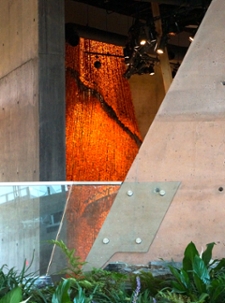Naming and the Visual Technologies of the CMHR
Tue. Oct. 14, 2014
by Cynthia Milton
photo credits: Karen Sharma
I had the fortune of being one of the 9,000 to be given a preview tour of sections of the Canadian Museum for Human Rights. The tour started with a walk through an earth-covered corridor entering the bowels of the building, then ascending along the many walkways that crisscross through the monumental building, until reaching the serenity pools, an area referred to as “the cloud” where we were invited to admire the all uniquely-sized window panes and the Tower of Hope which now defines Winnipeg’s skyline. At the tour’s end, we made our way back through dark passages to the bottom again.
Perhaps I am what Angela Failler would call a “hopeful kill joy” but the tour of Canada’s Museum for Human Rights seemed more of a tribute to the vision of an architect and the many donors whose names are prominently displayed at each room entry than a marking of the strength of individuals and groups who have fought to make what was not obvious or apparent now rights we hold. The enthusiasm of the youthful guides was palpable in both official languages in the repeated use of the word “cool”, an adjective used to describe the technology employed to project images on screens (mostly of smiling faces) or to describe with pride what appears to be a social tolerance dance floor of colour blobs that create more harmonious colours when people place themselves closer together.
Yet, despite a general sense of human rights as being a good thing, something we should celebrate, the materiality of human rights, and the struggle through human history to get to the culminating point of a museum constructed in their honour, seemed largely absent in this museum, despite the projection of a time line (which interestingly ends with the Declaration on the Rights of Indigenous Peoples, which Canada has yet to sign). This lack of materiality is also despite the Museums’ own symbolically important location as the meeting place of the Assiniboine and Red Rivers, on Treaty 1 land, just minutes away from where a citizen’s movement is dredging the Red River in search of the bodies of missing First Nations women. There is nothing to touch in the museum beyond computer screens. There are some beautiful and symbolically rich art pieces, such as Rebecca Belmore’s Trace formed by thousands of individually crafted beads, which has an unfortunate location tucked away on a wall, with an impeded view.

Perhaps in the remaining eight rooms not yet accessible there are objects; I am hopeful. As is, this museum is presently one that celebrates the universality of rights without a clear sense of what these rights are, and the struggles that went to define them.
In many memory monuments and museums (some which form the International Coalition of Sites of Conscience) naming is used as a means to indicate who had their rights abused. Names are inscribed on large walls, walkways, on stones. It is a practice that can prove thorny: how to arrange the names? in alphabetical order, by year of death, what about those for whom we do not yet have a name? In this practice that dates back to the Boer War (if not before), through the World Wars, the Holocaust, the Vietnam War, decolonization wars, and the various conflicts in the context of the Cold War (all moments as defining of human rights, for their being trampled), the victims are named, a silent but powerful reminder of some of the individuals for whom we now, in this museum, evoke the concept of human rights. Yet, these individuals seem largely absent in this space: we are greeted by a wall of nameless smiling faces that may be recognizable to some visitors. Rather, the only names we see are that of the donors at the Museum’s end, a wall of their names being projected and scrolled (organized according to their donation amount) as small groups of people gather to look on. Why would people stop to read these names, unless in search of something tangible?
Cynthia Milton is a member of the College of the Royal Society of Canada, Canada Research Chair in Latin American History, a member of the Centre for International Studies and Research at the Université de Montréal (CÉRIUM), and an affiliate with our partners at Concordia's Centre for Ethnographic Research and Exhibition in the Aftermath of Violence (CEREV). She was a participant in the CSRG's workshop, Museum Openings: Caring for Difficult Knowledge Within and Beyond the Canadian Museum for Human Rights.
